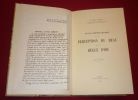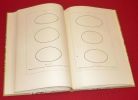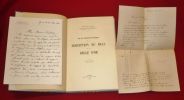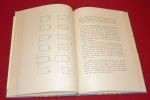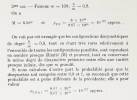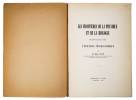11 books for « guye ch eug »Edit
-
Century
19th (1)
20th (4)
-
Topics
Biology (2)
Chemistry (4)
Medicine (1)
Physics (3)
Sciences (1)
-
Countries
Belgium (1)
Denmark (2)
France (5)
Switzerland (3)
-
Syndicate
ILAB (5)
NVVA (3)
SLACES (3)
Vérification expérimentale de la formule de Lorentz-Einstein par les rayons cathodiques de grande vitesse [19. July, 1915] (+) Errata. - [CONCLUSIVELY PROVING THE LORENTZ-EINSTEIN FORMULA]
(Paris, Bachelier" Genève, Pélisserie, 1915.) 4to. No wrappers. In: ""Comptes Rendus Hebdomadaires des Séances de L'Academie des Sciences"", Tome 161, No. 3 & No. 15 (Entires issues offered). Small stamp to top right corner of each issue. Pp. 45-60" Pp. 425-448. (Guye & Lavanchy's paper: Pp. 52-55" Pp. 447-8).
First appearance of Guye and Lavanchy's famous experimental confirmation the Lorentz-Einstein formula which eventually led to a full understanding and acceptance of Einstein's theory of relativity. Einstein himself, though known as not taking much interest in the experimental support of his conceptions, wrote eulogistic letters to Guye after the present paper had been published. In February 1906 Walter Kaufmann made public his conclusion on the experiments he had been performing since 1901 on the electric and magnetic deflections of beta-rays. He claimed that Lorentz' theory of the electron, and thus ""the possibility of founding physics on the principle of relative motion"", had to be rejected. Ten years had to pass until Guye and Lavanchy confirmed the Lorentz theory and thereby proving Kaufmann's measuring equipment for imprecise. In 1915 Guye and Lavanchy measured the deflection of cathode rays at 0.25c-0.5c. They used a tube with a cathode and anode in order to accelerate the rays. A diaphragm at the anode produced a beam which was deflected. A screen was placed at the end of the apparatus, at which the impacts were photographed by a camera. They subsequently computated the ratio of transverse electromagnetic mass mT and rest mass m0 indicated by the red and blue curve, and obtained good agreement with the Lorentz-Einstein formula. Their experiments were considered by many as conclusively proving the Lorentz-Einstein formula. ""Charles Lavanchy [and] Guye was able to develop very precise techniques for measuring particle deflections within carefully controlled electric and magnetic fields. In 1916 and 1921 Guye published these methods and pronounced results in favor of the Lorentzian formulas and Einsteinian theory. Thereafter his reputation rose as a most able experimenter among the world's physicists"". (DSB).
Vérification expérimentale de la formule de Lorentz-Einstein par les rayons cathodiques de grande vitesse [19. July, 1915] (+) Vérification expérimentale de la formule de Lorentz-Einstein par les rayons cathodiques de grande vitesse [October 1915]. - [CONCLUSIVELY PROVING THE LORENTZ-EINSTEIN FORMULA]
Paris, Bachelier" Genève, Pélisserie, 1915. 4to and 8vo. Both in the original wrapper. Offprints from ""Comptes Rendus Hebdomadaires des Séances de L'Academie des Sciences"", tome 161, P. 52, 19 juillet 1915 [4to] and ""Archives des Sciences physiques et naturelles"", Tome XL, October 1915 [8vo]. Paper from ""Compte Rendu"" folded in half and ""Archives des Sciences physiques"" has a few nicks to extremities, otherwise to very fine and clean copies. [4to:] 4 pp."" [8vo:] 11 pp.
Two fine offprint issues of Guye and Lavanchy's famous experimental confirmation the Lorentz-Einstein formula which eventually led to a full understanding and acceptance of Einstein's theory of relativity. Einstein himself, though known as not taking much interest in the experimental support of his conceptions, wrote eulogistic letters to Guye after the present paper had been published. In February 1906 Walter Kaufmann made public his conclusion on the experiments he had been performing since 1901 on the electric and magnetic deflections of beta-rays. He claimed that Lorentz' theory of the electron, and thus ""the possibility of founding physics on the principle of relative motion"", had to be rejected. Ten years had to pass until Guye and Lavanchy confirmed the Lorentz theory and thereby proving Kaufmann's measuring equipment for imprecise. In 1915 Guye and Lavanchy measured the deflection of cathode rays at 0.25c-0.5c. They used a tube with a cathode and anode in order to accelerate the rays. A diaphragm at the anode produced a beam which was deflected. A screen was placed at the end of the apparatus, at which the impacts were photographed by a camera. They subsequently computated the ratio of transverse electromagnetic mass mT and rest mass m0 indicated by the red and blue curve, and obtained good agreement with the Lorentz-Einstein formula. Their experiments were considered by many as conclusively proving the Lorentz-Einstein formula. ""Charles Lavanchy [and] Guye was able to develop very precise techniques for measuring particle deflections within carefully controlled electric and magnetic fields. In 1916 and 1921 Guye published these methods and pronounced results in favor of the Lorentzian formulas and Einsteinian theory. Thereafter his reputation rose as a most able experimenter among the world's physicists"". (DSB).
Sur les conditions physiques de la Perception du Beau et la Règle d'Or. Avec 11 figures.
Genève, Imprimerie Albert Kundig, 1933, 1 volume in-8 de 250x160 mm environ, 50 pages, demi reliure à coins en toile beige, couvertures conservées. Tirage à 140 exemplaires avec une lettre d'Henri Focillon. Bon état.
Charles-Eugène Guye, né le 15 octobre 1866 à Saint-Christophe, commune de Champvent dans le canton de Vaud, Suisse et mort le 15 juillet 1942 à Genève, est un physicien suisse. Merci de nous contacter à l'avance si vous souhaitez consulter une référence au sein de notre librairie.
Sur les conditions physiques de la Perception du Beau et la Règle d'Or. Avec 11 figures.
Genève, Imprimerie Albert Kundig, 1933, 1 volume in-8 de 250x160 mm environ, 50 pages, demi reliure à coins en toile bleue, couvertures conservées. Tirage à 140 exemplaires avec 2 Lettres de correspondance dont une de l'auteur. Bon état.
Charles-Eugène Guye, né le 15 octobre 1866 à Saint-Christophe, commune de Champvent dans le canton de Vaud, Suisse et mort le 15 juillet 1942 à Genève, est un physicien suisse. Merci de nous contacter à l'avance si vous souhaitez consulter une référence au sein de notre librairie.
Vérification expérimentale de la formule de Lorentz-Einstein faite au laboratoire de physique de l'Universite de Geneve, en coll. succ. avec S. Ratnowsky et Ch. Lavanchy. ‘Mémoires de la soc. de physique et d'histoire nat. de Genève’ Vol. 39, Fasc. 6.
Genève, Georg & Cie, 1921, gr. in-4to, S. 273 - 364 + 3 planches, cachet sur titre, brochure originale, sans couverture.
Première édition qui présente le fascicule même des ‘Mémoires de la Société de Physique’, ... 2 planches montrent des vérifications au laboratoire.

(SLACES, NVVA)
Phone number : 41 (0)26 3223808
Les hypothèses modernes sur la constitution électrique de la matière. Rayons cathodiques et corps radioactifs [2 volumes] I: Theorie electrique de la matière, II: Les arguments tirés de l'expérience
Geneve, Henry Kundig 1904 2 tomes: 28pp. & pp.188-223, 25cm., br.orig., extrait du Journal de chimie physique (1904)
Sur la polarisation rotatoire du quartz aux basses températures
Genève, Bureau des Archives, 1893, in-8, 14pp, 1pl, broché, couverture bleue, Extrait des "Archives des sciences physiques et naturelles", 3° période, t.29, n°3, mars 1893, p.242. POGGENDORFF, IV-1416. Joint: BOREL (Arnold). Sur la polarisation rotatoire magnétique du quartz. Genève, Société Générale d'imprimerie, 1903. In-8, 44pp, 1pl. Broché. Extrait des "Archives des sciences physiques et naturelles", 4° période, t.16, juillet-août 1903. Thèse de Borel, qui dédie son travail à Charles Soret 14pp., 1pl.
L'évolution Physico-chimique.
P., Etienne Chiron, 1922. In 8 broché, 112 pp., (dos fendu, bords du premier plat fragiles avec manque à un angle).
****
L'évolution physico-chimique. 2 ouvrages dans 1 volume: L'évolution physico-chimique. Les frontières de la physique et de la biologie. Plus appendice. Préface de P. Lecomte du Noüy. 2e édition (revue et corrigée par l'auteur).
Paris, (Albert Kundig à Genève pour) Hermann, 1942, in-8°, XII + 309 p., qqs. illustrations, reliure en toile originale. / BOUND COPY of the 2nd. edition.
Two of Guye's major scientific works. The first editions were published in 1922 (in fact the work reproduces three articles published from 1917 to 1920) and in 1936 (six articles published from 1934 to 1936). The appendice contains the following titles: «Quelques réflexions sur la ‘philosophie scientifique’» (1936), and «Un aperçu sur l'évolution de la pensée des physiciens» (1939).“Guye was a member of a distinguished Swiss family. With his older brother, Philippe-Auguste (1862-1922), he pioneered in investigating phenomena on the borderline between physics and chemistry. ... Charles-Eugène became primarily a physicist. Interested in electro-magnetism and molecular size determinations, he gained recognition for his precise measurements of variation of the mass of electrons as a function of their velocity, and as director of physical laboratories at the university of Geneva. Together and separately, the two Guyes achieved distinction in their different disciplines by devising experimental means for analyzing interface phenomena in physical chemistry and chemical physics. The books that he published on the evolution of statistical thermodynamics and on reductionism in physics and biology show the breath of his interests and the vitality of his mind.” (DSB). “Il y a donc dans cet ouvrage une riche substance, qui doit être pour le lecteur libre de tout esclavage intellectuel, et débarassé d'idées préconcues, une source inépuisable de réflexion et d'inspiration.” (de la préface à cette 2e édition).Dictionary of Scientific Biography V/597-598.

(SLACES, NVVA)
Phone number : 41 (0)26 3223808
L'évolution physico-chimique, l'évolution physico-chimique - les frontières de la physique et de la biologie - appendice
Hermann 1942 In-4 reliure éditeur pleine toile, 25 cm sur 16,9. 308 pages. Bon état d’occasion.
Bon état d’occasion
Les frontières de la physique et de la biologie. Étude faisant suite à L’évolution physico-chimique.
Genève, Imprimerie A. Kundig, 1936, in-8°, 134 p., non coup., reliure en toile originale. 2ème couv. avec pte. trou.
Image disp.

(SLACES, NVVA)
Phone number : 41 (0)26 3223808
 Write to the booksellers
Write to the booksellers